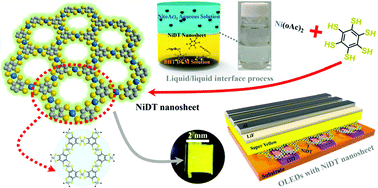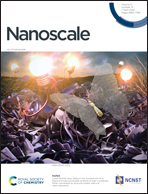Solution-processed organometallic quasi-two-dimensional nanosheets as a hole buffer layer for organic light-emitting devices†
Abstract
Two-dimensional (2D) vdW materials have been integrated into optoelectronic devices to achieve exceptional functionality. However, the integration of large-area 2D thin films into organic light-emitting devices (OLEDs) remains challenging because of the finite number of inorganic 2D materials and the high-temperature requirements of their deposition process. The construction of 2D organometallic materials holds immense potential because of their solution synthesis and unlimited structural and functional diversity. Here, we report a facile route using an oil–water interfacial coordination reaction between organic ligands and divalent metal ions to synthesize crystalline quasi-2D organometallic bis(dithiolato)nickel (NiDT) nanosheets with a centimeter scale and a tunable thickness. The NiDT nanosheets can be directly integrated into OLEDs for use as a hole buffer layer and a fluorescent mounting medium without the aid of a transfer process. Moreover, OLEDs with NiDT nanosheets show not only comparable efficiency to conventional OLEDs but also prolonged device lifetime by nearly 2 times. These results open up a new dimension to use quasi-2D organometallic nanosheets as functional layers in large-area organic devices.



 Please wait while we load your content...
Please wait while we load your content...